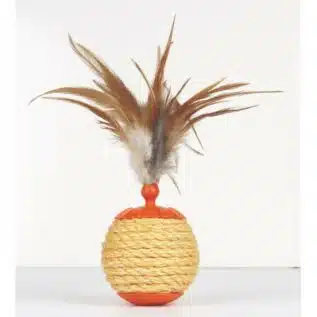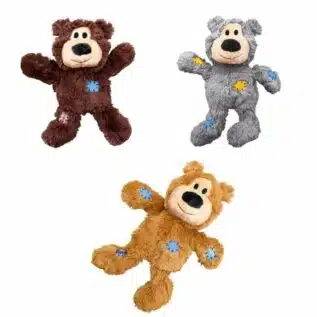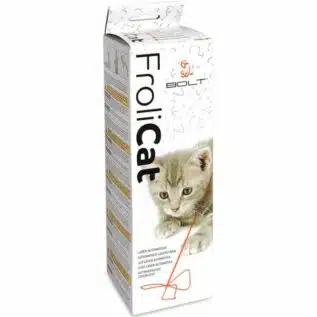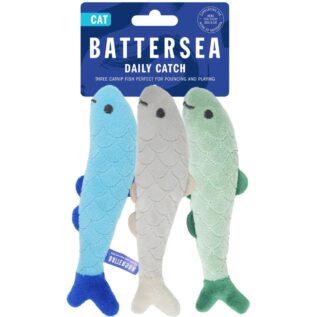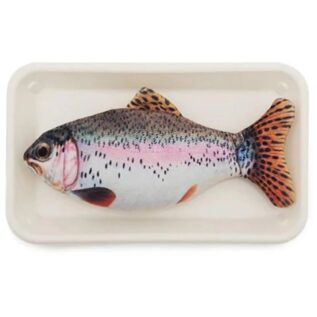How to Choose the Perfect Cat Toys for your Feline Friend
Introduction to Cat Toys
Who said toys are only for kids? Cats, too, love to play! Toys not only keep them entertained but also provide the necessary exercise for their mental and physical health. In this guide, we will explore how to choose the perfect toys for your feline friend.
Understanding Cat Behavior
Why Cats Need Toys
Cats, whether indoor or outdoor, are incredibly active and curious creatures. They need constant mental and physical stimulation to maintain their wellbeing. Toys play a vital role in providing this stimulation.
Cats love to explore and discover, and toys offer a fantastic opportunity for this exploration. They allow cats to engage their natural instincts in a safe and controlled environment, reducing the likelihood of destructive behavior.
Beyond the physical aspect, toys also provide the mental stimulation that cats need to stay happy and healthy. They challenge cats' curiosity, problem-solving skills, and ability to adapt to new situations. This mental engagement helps keep your feline friend's brain sharp and alert.
The Hunting Instinct
Cats are natural-born hunters. This instinct is a part of their genetic makeup, stemming from their wild ancestors. They are hardwired to stalk, chase, and pounce – behaviors that you'll likely see during their playtime.
A mouse toy or a feathered teaser can stimulate their hunting instinct. These types of toys mimic the movements and textures of prey, offering a satisfying (and safe) hunting experience. These games provide a healthy outlet for your cat's inherent desires and keep them physically active.
For instance, when playing with a feathered teaser, your cat can practice stalking and pouncing, just like they would in the wild. This activity can offer endless entertainment for your cat, keep them fit, and satisfy their hunting instinct.
How Cats Play
Understanding how cats play can significantly impact the toys you choose for them. Cats play differently based on their individual preferences and what they consider as 'prey'.
For example, some cats prefer toys that mimic birds. They enjoy the thrill of 'hunting' a creature that flits around quickly, much like a bird does. Feathered teasers or toys that dangle from strings can satisfy this preference, as they simulate the movements of birds.
On the other hand, some cats might prefer ground prey like mice or small critters. They enjoy the chase, the pounce, and the 'kill' of their pretend prey. In this case, toy mice, balls, or other ground-moving toys can provide hours of fun.
However, the key to keeping your cat's interest in toys is variety. Cats are notoriously picky and can quickly lose interest in their toys. By providing a mix of different toys that cater to various preferences, you ensure your cat has a stimulating and engaging playtime.
Remember, playtime isn't just fun for your cat; it's an essential part of their health and happiness. By understanding their play behavior and preferences, you can choose toys that will enrich their lives and strengthen your bond with them.
Different Types of Cat Toys
Interactive Toys
Interactive toys are designed to engage your cat in a fun and stimulating activity. They generally require your cat to perform a certain action to trigger a response or get a reward. For instance, a treat-dispensing toy may release a small amount of food each time your cat nudges it in a particular way. Similarly, a wand toy requires your cat to chase and capture the 'prey' at the end of the string.
The main benefits of interactive toys include:
- Physical exercise: Cats need regular physical activity to maintain a healthy weight and overall wellbeing. Interactive toys encourage movement, agility, and coordination.
- Mental stimulation: Interactive toys challenge your cat's problem-solving skills, as they try to figure out how to get the toy to react.
- Boredom prevention: With their varied responses, interactive toys can keep your cat engaged for extended periods, reducing boredom and associated behavioral issues.
Puzzle Toys
Puzzle toys take mental stimulation a step further. These toys often involve hidden treats that your cat has to work to uncover. They might need to slide pieces around, push levers, or perform other complex actions.
Puzzle toys help cats exercise their natural curiosity and problem-solving skills. These toys can be particularly beneficial for indoor cats who may not have as many natural challenges in their environment.
Plus, because they often involve food or treats, puzzle toys can also slow down fast eaters and provide entertainment for cats who are highly food motivated.
Mice and Laser Toys
Mice toys and laser toys cater to your cat's natural hunting instincts.
Mice toys are generally small, lightweight, and easy for your cat to bat around. Many of these toys also include features like realistic fur textures or squeaking noises to more closely mimic real mice. Cats can chase, pounce on, and carry these toys, providing a satisfying simulated hunting experience.
Laser toys, on the other hand, provide high-speed chases that many cats love. The fast-moving laser dot mimics the erratic movements of a small critter, triggering your cat's desire to hunt. However, it's essential to never shine the laser directly into a cat's eyes, and always finish play sessions with a physical toy your cat can catch, to give them a sense of accomplishment.
It's also worth noting that while these toys can provide hours of fun, they should be part of a balanced 'toy diet' that also includes interactive playtime with you. After all, nothing can substitute the bonding and engagement provided by playtime between you and your feline friend.
How to Introduce New Toys to Your Cat
Introducing new toys to your cat is an important process that should be handled with care. Here's a step-by-step guide on how you can do this effectively.
- Present the New Toy: The first step is to present the new toy to your cat. However, don't immediately start playing with it. Instead, just leave it out in a space where your cat usually spends their time. Cats are naturally curious, so they're likely to investigate this new object in their environment.
- Allow Exploration: Let your cat sniff and explore the toy at their own pace. This exploratory phase allows your cat to get used to the toy's scent, shape, and texture. It also helps reduce any fear or anxiety your cat may have towards the new object.
- Engage in Play: Once your cat seems comfortable with the new toy's presence, try to engage them in play. This might involve moving the toy around in a way that mimics prey, like twitching a feather toy or rolling a ball. Make sure to let your cat 'win' by catching the toy regularly, as this helps build confidence and enjoyment.
- Monitor Their Reaction: Pay close attention to your cat's reaction during this play session. If they seem scared or anxious, it might be best to try a different type of toy or introduce the toy more slowly. If they're enjoying themselves, continue with the play session.
- Give Breaks: After your cat has been playing for a while, give them a break. Overstimulation can lead to aggression in some cats. Additionally, breaks help maintain interest in the toy over time.
- Leave the Toy Out: If your cat seems to enjoy the new toy, leave it out when playtime is over. This allows your cat to continue exploring the toy on their own terms. However, if the toy has small parts or is potentially unsafe without supervision, store it away safely when it's not in use.
Remember that every cat is unique, so what works for one might not work for another. You know your cat best, so always consider their likes and dislikes when introducing a new toy. And always supervise the first few play sessions with a new toy to ensure it's safe and appropriate for your cat.
Keeping Your Cat Interested in Their Toys
Just like humans, cats can get bored if they do the same thing over and over again. This also applies to their toys. If your cat plays with the same toys every day, they may eventually lose interest. To prevent this, here are some tips to keep your cat interested in their toys:
- Rotate Toys: Instead of giving your cat access to all their toys at once, try rotating them on a weekly basis. This means that each week, you offer a different set of toys for your cat to play with. Rotating toys can help keep your cat's interest as they'll perceive each rotation as a new set of toys to explore and play with. It keeps their environment stimulating and exciting.
- Introduce New Toys: Every once in a while, introduce a new toy into your cat's rotation. This can bring novelty and excitement to their playtime. However, remember to introduce new toys gradually, as outlined in the previous section.
- Interactive Play: Try to spend some time each day playing with your cat and their toys. Interactive play can be more stimulating and fun for your cat than playing alone. Use toys like wand toys, laser pointers, or toys that require joint interaction. This not only helps keep your cat interested in their toys but also strengthens your bond with them.
- Use Treat-Dispensing Toys: Cats love treats. Using treat-dispensing toys or puzzle toys that reward your cat with a treat can keep them interested in the toy. This also stimulates their problem-solving skills as they figure out how to get the treat.
- Simulate Prey Behavior: Cats are natural hunters, so they love toys that mimic the behavior of their prey. Make their toys "run away" from them or "hide," and let them "catch" their prey. This satisfies their hunting instincts and keeps them engaged.
- Keep Toys Clean: Just like humans, cats prefer clean toys. Dirty toys may not only turn your cat off, but they can also harbor bacteria that might cause infections. Regularly cleaning your cat's toys can help keep your cat healthy and interested in their toys.
Remember, every cat is different. What works for one cat might not work for another. It's essential to observe your cat's behavior and adjust your strategies based on their preferences.
Conclusion
Choosing the perfect cat toy might seem overwhelming, but understanding your cat's behaviors and preferences can make it easier. The right toys will keep your cat entertained, active, and healthy.
Frequently Asked Questions
How often should I replace my cat's toys?
Cats' toys should be replaced when they start to show signs of significant wear and tear, or when your cat loses interest in them. This varies depending on the type of toy and how much your cat plays with it. If a toy becomes torn, it can pose a choking hazard or other risk to your cat, so it's important to replace it promptly. Also, introducing new toys periodically can keep your cat's interest and provide mental stimulation.
Are laser toys safe for cats?
Yes, laser toys can be safe and entertaining toys for cats, but it's crucial never to point the laser directly into a cat's eyes as it can cause damage. Also, it's essential to allow your cat to 'catch' something physical during laser play. This is because the inability to physically catch anything after a long chase can lead to frustration in some cats.
Can my cat play with toys when I'm not home?
While it might seem like more toys would be better, having too many toys out at once can overwhelm some cats and cause them to lose interest. It's often better to have a rotation of toys that you switch out every week or so. This gives the cat a sense of novelty and keeps their interest in playtime.
Can a cat have too many toys?
Yes, most invisible fence kits are designed for DIY installation and come with comprehensive instructions. Wireless and GPS fences are relatively straightforward to install, but wired or in-ground fences may require more effort, including digging to bury the wires. If you're not comfortable with this, you might consider hiring a professional to install it.
What are the best toys for kittens?
Interactive toys and toys that encourage chasing and hunting behaviors are particularly good for kittens. Kittens have a lot of energy and are in a prime socialization period, so toys that stimulate them and provide interaction are ideal. Puzzle toys can also be good for mental stimulation. Remember, though, safety is paramount. Always ensure toys are suitable for your kitten's size and don't contain small parts they could swallow.

